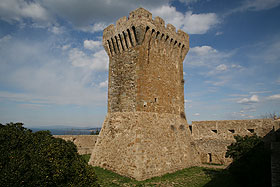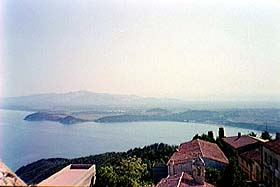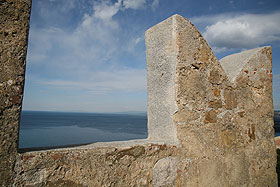Rocca of Populonia
 |
 |
The circular half-tower, called 'Exedra', and the Keep dominating the curtains wall. |
The keep, medieval original nucleus of the Fortress. |
Populonia can be reached from Florence through the motorway A11 'til 'Pisa Nord' then the A12 towards Livorno, exit at 'Rosigano-Cecina' and the following the SS1 Aurelia. It is about 18 km far from S.Vincenzo.
 The fame of Populonia is not owed to its Rocca but to
the fact that was the Etruscan town of Pupluna or Fufluna, one
of the more ancient and prestigious human settlements of the whole Tuscany. The archeological recovery of its wide necropolis
confirm that the area was inhabited at least from the Neolithic era. Pupluna
was one of the most important cities of the Etruscan civilization and
it was the only one, between the greatest settlements, to rise on the
coast. This allowed the city to be a commercial and industrial
point of reference between the centers of the hinterland and the islands of the
Tuscan archipelago, thanks to the presence of many fusion ovens for the
metals extracted in the near mines. The urban nucleus was composed of
two parts: that of the 'Acropoli', at dominion of the Baratti
gulf and
that industrial, on the coast, with the naval
port and the ovens.
The fame of Populonia is not owed to its Rocca but to
the fact that was the Etruscan town of Pupluna or Fufluna, one
of the more ancient and prestigious human settlements of the whole Tuscany. The archeological recovery of its wide necropolis
confirm that the area was inhabited at least from the Neolithic era. Pupluna
was one of the most important cities of the Etruscan civilization and
it was the only one, between the greatest settlements, to rise on the
coast. This allowed the city to be a commercial and industrial
point of reference between the centers of the hinterland and the islands of the
Tuscan archipelago, thanks to the presence of many fusion ovens for the
metals extracted in the near mines. The urban nucleus was composed of
two parts: that of the 'Acropoli', at dominion of the Baratti
gulf and
that industrial, on the coast, with the naval
port and the ovens.
 As all the Etruscan
cities, Populonia knew the decadence with the progressive grow of the power of Rome, also suffered
a serious destruction for hand of Silla during the roman civil war against Mario.
Already in the 1st century A.C. the city was
desert with the houses ruined
and the ovens abandoned. In the following centuries there was attempts
to reactivate the sea port and the industrial activities connected to
it, but the life in the city never took back big vigor, also because
of the invasions and piracy raids to which it was exposed. Populonia reborn
in the Middle Age when in the 14th century was decided to built
a new castle, that still today dominates the hill of
the ancient Etruscan Acropoli.
As all the Etruscan
cities, Populonia knew the decadence with the progressive grow of the power of Rome, also suffered
a serious destruction for hand of Silla during the roman civil war against Mario.
Already in the 1st century A.C. the city was
desert with the houses ruined
and the ovens abandoned. In the following centuries there was attempts
to reactivate the sea port and the industrial activities connected to
it, but the life in the city never took back big vigor, also because
of the invasions and piracy raids to which it was exposed. Populonia reborn
in the Middle Age when in the 14th century was decided to built
a new castle, that still today dominates the hill of
the ancient Etruscan Acropoli.
 The Fortress appears
with the form of the fortifications that suffered the greatest rehashes
during the period of transition
from the medieval castle to the military bastioned fortresses of
the end of the 15th century. Unlike many other castles, completely denaturalized
in the forms and in the aspect due to the additions of this period, the
element that dominates the complex it is still the mighty tower with
rectangular plan that was the primitive medieval keep.
The tower is not built
with perfectly squared stones at exception of the angles and it's provided
of bastionated walls, machicoulis (opening
between corbels of the parapet through which the defenders can drop
rocks or fire projectiles against
an enemy directly below them, surely added during the updating of the
fortification) and big battlements, three on the short sides four on
those long, gifted of double slope, toward the inside and toward the
outside,
rare form to find in the Tuscan castles although very diffused in those
of the Scaligeri family of the northern Italy. The gate of the
keep is
at the level of the first floor. Around the tower are developed the enclosure
walls, built in the 15th century with a square plant very near to be
rectangular,
with a watch walk alternated by vertical loopholes toward the outside.
To the four angles are present external garrittes.
The Fortress appears
with the form of the fortifications that suffered the greatest rehashes
during the period of transition
from the medieval castle to the military bastioned fortresses of
the end of the 15th century. Unlike many other castles, completely denaturalized
in the forms and in the aspect due to the additions of this period, the
element that dominates the complex it is still the mighty tower with
rectangular plan that was the primitive medieval keep.
The tower is not built
with perfectly squared stones at exception of the angles and it's provided
of bastionated walls, machicoulis (opening
between corbels of the parapet through which the defenders can drop
rocks or fire projectiles against
an enemy directly below them, surely added during the updating of the
fortification) and big battlements, three on the short sides four on
those long, gifted of double slope, toward the inside and toward the
outside,
rare form to find in the Tuscan castles although very diffused in those
of the Scaligeri family of the northern Italy. The gate of the
keep is
at the level of the first floor. Around the tower are developed the enclosure
walls, built in the 15th century with a square plant very near to be
rectangular,
with a watch walk alternated by vertical loopholes toward the outside.
To the four angles are present external garrittes.
During a successive phase was added at the center western front of the walls a round half-tower, similar to an exedra, gifted of an ample bastionature and crowned by Ghibelline battlements (at tail of swallow) each endowed with a small loophole and machicoulis. Also this half tower is gifted of watch walk and it also possesses a wall with loopholes on the courtyard side, to defend from the enemies in the case of penetration of the fortification. This construction could be considered a decisive footstep toward the development of those that will be the round towers of the fortresses of the 16th century. In this point the fortress walls are connected with those of the suburb. The Rocca of Populonia had always purely military functions. The visit to the fortification is important because it can be considered a fundamental point for the fortified architecture in the passage from the castle to the fortress.
| More Photos |
| Back to Homepage |
| Back to Castles Index |